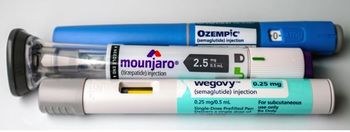
Dermatomyositis and Nevus Achromicus
July 2008 Dermclinic
Case 1:
For several months, a 44-year-old woman has had a rash on her upper extremities and face. She also complains of fatigue. Another physician initially ruled out a connective tissue disease based on a negative anti- nuclear antibody (ANA) test and normal muscle enzyme levels.
Which of the conditions in the differential do you suspect?
A. Polymorphous light eruption.
B. Systemic lupus erythematosus.
C. Dermatomyositis.
D. Photodrug eruption.
E. Psoriasis.
(Answer on next page.)
Case 1: Dermatomyositis
Given the photodistribution of the rash and the patients complaint of fatigue, dermatomyositis, C, was suspected, despite the normal blood test results. A skin biopsy supported the clinical diagnosis. Other diagnostic criteria for dermatomyositis are listed in the Table. Although the mainstay of treatment is prednisone, the goal is to find effective steroid-sparing options-such as methotrexate, azathioprine, or hydroxychloroquine-to minimize side effects.
Other photosensitive diseases such as polymorphous light eruption, lupus, and photodrug reactions are possibilities, which the biopsy will help differentiate. Psoriasis usually has a different distribution than that seen in this patient; it typically appears on the extensor surfaces of the knees and elbows, the scalp, and the trunk.
Table - Diagnostic criteria for dermatomyositis
• Skin lesions
• Heliotrope rash
• Gottron papules or sign
• Proximal muscle weakness
• Muscle pain
• Elevated creatine kinase or aldolase level
• Electromyographic changes
• Presence of anti–Jo-1 antibody (histadyl tRNA synthetase)
• Nondestructive arthritis or arthralgia
• Fever, elevated erythrocyte sedimentation rate or C-reactive protein level
Case 2:
Linear hypopigmented streaks are noted on the upper arm of an 8-year-old girl. They have been present since shortly after birth. There is no history of trauma. No one else in the family has similar lesions.
What does this look like to you?
A. Vitiligo.
B. Hypomelanosis of Ito.
C. Nevus achromicus.
D. Incontinentia pigmenti achromians.
E. Factitial dermatitis.
Bonus question:
What is the significance, if any, of these lesions?
(Answer on next page.)
Case 2:
Case 2: Nevus achromicus
Hypomelanosis of Ito, B, nevus achromicus, C, and incontinentia pigmenti achromians, D, are the names ascribed to bilateral or unilateral hypopigmentation that follows the lines of Blaschko; the lesions are usually present at birth or appear shortly thereafter. In most patients, repigmentation eventually occurs spontaneously
Answer to the bonus question:
Between one-third and three-quarters of affected persons have associated CNS anomalies. About half have chromosomal abnormalities, and most of these patients demonstrate mosaicism.1
REFERENCE:
1. Ruggieri M, Pavone L. Hypomelanosis of Ito: clinical syndrome or just phenotype? J Child Neurol. 2000;15:635-644.
Case 3:
A 72-year-old man presents for a routine skin examination. This asymp- tomatic lesion on his chest appeared shortly after open heart surgery 19 years earlier.
What is your clinical impression?
A. Basal cell carcinoma.
B. Seborrheic keratosis.
C. Foreign-body reaction to suture.
D. Keloid.
E. Squamous cell carcinoma.
(Answer on next page.)
Case 3: Basal cell carcinoma
A biopsy confirmed the diagnosis of basal cell carcinoma, A. In one study, more than 7% of basal cell carcinomas occurred at sites of previous injury, including sharp or blunt trauma, chickenpox scars, burns, and vaccinations.1
Squamous cell carcinoma is usually a nodule with a keratotic center rather than this patient's pearly lesion. A keloid would follow the pattern of the scar. Foreign bodies typically produce more inflammation than what is seen here. Seborrheic keratosis has a characteristic pebbled surface with keratin-filled follicles.
REFERENCE:
1. Noodleman FR, Pollack SV. Trauma as a possible etiologic factor in basal cell carcinoma. J Dermatol Surg Oncol. 1986;12:841-846.
Newsletter
Enhance your clinical practice with the Patient Care newsletter, offering the latest evidence-based guidelines, diagnostic insights, and treatment strategies for primary care physicians.

































































































































































































































































































